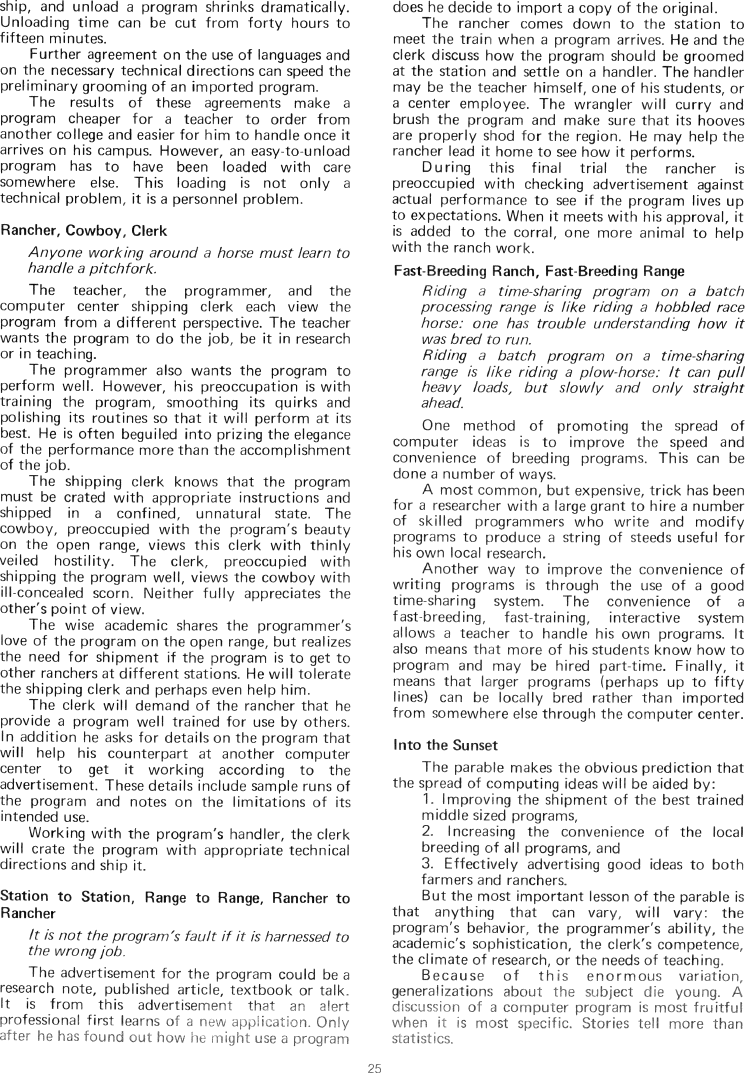The Best of Creative Computing Volume 1 (published 1976)
The Parable of the Horse

ship, and unload a program shrinks dramatically.
Unloading time can be cut from forty hours to
fifteen minutes.
Further agreement on the use of languages and
on the necessary technical directions can speed the
preliminary grooming of an imported program.
The results of these agreements make a
program cheaper for a teacher to order from
another college and easier for him to handle once it
arrives on his campus. However, an easy-to-unload
program has to have been loaded with care
somewhere else. This loading is not only a
technical problem, it is a personnel problem.
Rancher, Cowboy, Clerk
Anyone working around a horse must learn to
handle a pitchfork.
The teacher, the programmer, and the
computer center shipping clerk each view the
program from a different perspective. The teacher
wants the program to do the job, be it in research
or in teaching.
The programmer also wants the program to
perform well. However, his preoccupation is with
training the program, smoothing its quirks and
polishing its routines so that it will perform at its
best. He is often beguiled into prizing the elegance
of the performance more than the accomplishment
of the job.
The shipping clerk knows that the program
must be crated with appropriate instructions and
shipped in a confined, unnatural state. The
cowboy, preoccupied with the program's beauty
on the open range, views this clerk with thinly
veiled hostility. The clerk, preoccupied with
shipping the program well, views the cowboy with
ill-concealed scorn. Neither fully appreciates the
other's point of view.
The wise academic shares the programmer's
love of the program on the open range, but realizes
the need for shipment if the program is to get to
other ranchers at different stations. He will tolerate
the shipping clerk and perhaps even help him.
The clerk will demand of the rancher that he
provide a program well trained for use by others.
In addition he asks for details on the program that
will help his counterpart at another computer
center to get it working according to the
advertisement. These details include sample runs of
the program and notes on the limitations of its
intended use.
Working with the program's handler, the clerk
will crate the program with appropriate technical
directions and ship it.
Station to Station, Range to Range, Rancher to
Rancher
It is not the program 's fault if it is harnessed to
the wrong job.
The advertisement for the program could be a
research note, published article, textbook or talk.
It is from this advertisement that an alert
professional first learns of a new application. Only
after he has found out how he might use a program
does he decide to import a copy of the original.
The rancher comes down to the station to
meet the train when a program arrives. He and the
clerk discuss how the program should be groomed
at the station and settle on a handler. The handler
may be the teacher himself, one of his students, or
a center employee. The wrangler will curry and
brush the program and make sure that its hooves
are properly shod for the region. He may help the
rancher lead it home to see how it performs.
During this final trial the rancher is
preoccupied with checking advertisement against
actual performance to see if the program lives up
to expectations. When it meets with his approval, it
is added to the corral, one more animal to help
with the ranch work.
Fast-Breeding Ranch, Fast-Breeding Range
Riding a time-sharing program on a batch
processing range is like riding a hobbled race
horse: one has trouble understanding how it
was bred to run.
Riding a batch program on a time-sharing
range is like riding a plow-horse: It can pull
heavy loads, but slowly and only straight
ahead.
One method of promoting the spread of
computer ideas is to improve the speed and
convenience of breeding programs. This can be
done a number of ways.
A most common, but expensive, trick has been
for a researcher with a large grant to hire a number
of skilled programmers who write and modify
programs to produce a string of steeds useful for
his own local research.
Another way to improve the convenience of
writing programs is through the use of a good
time-sharing system. The convenience of a
fast-breeding, fast-training, interactive system
allows a teacher to handle his own programs. It
also means that more of his students know how to
program and may be hired part-time. Finally, it
means that larger programs (perhaps up to fifty
lines) can be locally bred rather than imported
from somewhere else through the computer center.
Into the Sunset
The parable makes the obvious prediction that
the spread of computing ideas will be aided by:
1. Improving the shipment of the best trained
middle sized programs,
2. Increasing the convenience of the local
breeding of all programs, and
3. Effectively advertising good ideas to both
farmers and ranchers.
But the most important lesson of the parable is
that anything that can vary, will vary: the
program's behavior, the programmer's ability, the
academic's sophistication, the cIerk's competence,
the climate of research, or the needs of teaching.
Because of this enormous variation,
generalizations about the subject die young. A
discussion of a computer program is most fruitful
when it is most specific. Stories tell more than
statistics.


